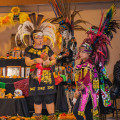In prehistoric times, parts of the landforms now found in Contra Costa County were populated by a wide range of now extinct mammals. In the northern part of the county, significant coal and sand deposits formed in even earlier geological eras. Other areas of the county have ridges that expose old but intact seashells, embedded in layers of sandstone that alternate with limestone. At the site of some road excavations, layers of volcanic ash can be seen ejected from geologically recent but now extinct volcanoes, compacted and now tilted by compressive forces.
This county is an agglomeration of several different geological terrains, as is most of the San Francisco Bay metropolitan area, which is one of the most geologically complex regions in the world. The great local mountain, Monte Diablo, was formed and continues to rise by the compressive forces resulting from the action of plate tectonics and, at its top, it has old rocks from the seabed, scraped from distant places of ocean sedimentation and accumulated and raised by these great forces. Younger deposits at medium altitudes include pillow-type lavas, the product of underwater volcanic eruptions. The first occupation definitely established by modern man (Homo sapiens) seems to have occurred between six and ten thousand years ago.
However, the human presence may have existed much earlier, at least as far as unsettled populations are concerned. The well-known settled populations were hunter-gatherer societies that did not know metals and that produced the highest quality, most aesthetically attractive, utilitarian handicrafts for daily use (especially woven reeds baskets). Extensive trade from tribe to tribe transferred exotic materials such as obsidian (useful for making arrowheads and other stone tools) throughout the region from distant California tribes. Unlike the native American nomads of the Great Plains, it seems that these tribes did not incorporate war into their culture, but, in general, cooperated.
Within these cultures, the concept of individual or collective ownership of land did not exist. However, the region's first European settlers didn't record much about native culture. Most of what is known culturally comes from preserved contemporary and excavated artifacts and from intergenerational knowledge transmitted through the peripheral tribes of the north of the larger region. Land titles in Contra Costa County can be attributed to multiple subdivisions of a few original land grants.
The dealer's last names persist in some city and town names, such as Martínez, Pacheco, and Moraga, and in the names of streets, residential subdivisions, and business parks. Some of the most prosperous farm mansions have been preserved as museums and cultural centers, and one of the most rustic examples has been preserved as a functioning demonstration ranch, Rancho Borges. With the post-war birth rate boom and the desire to live in the suburbs, large housing developers would buy large farms in the center of the county and develop them with roads, utilities, and housing. The area was initially developed as low-cost large-lot suburbs with a typical low-cost house located on a quarter-acre (1,000 m) land with 10,000 square feet (930 m).
Part of this expansion was due to whites fleeing decaying areas in Alameda County and San Francisco; however much was due to post-war baby boomers seeking three- and four-bedroom homes with large patios that were unaffordable or unavailable in established cities along the bay. Several large companies followed their employees to these suburbs filling large business parks. This created a demand for extensive support infrastructure including roads, schools, libraries, police departments, firefighting services, water systems, sewerage systems and flood control measures. The county's central cities have created their own suburbs within Contra Costa County which extend eastward along its northern estuarine coast; former Bay Point and Pittsburg development areas have been augmented by extensive development in Antioch Oakley and Brentwood.
According to Census Bureau data Contra Costa County has a total area of 804 square miles (2 080 km), 716 square miles (1 850 km) being land while 88 square miles (230 km) (11%) is water. The Hayward fault zone runs through western part of county from Kensington to Richmond while Calaveras Fault extends south-central part from El Alamo to San Ramón. The Concord fault runs through part of Concord and Pacheco while Clayton-Marsh Creek-Greenville fault extends from Clayton at its north end to near Livermore. These landslide faults along with Diablo thrust fault near Danville can cause significantly destructive earthquakes; many related minor faults are present in area running through critical infrastructure such as water pipes natural gas oil products roads highways railroads BART rail transit etc.
The county's most notable natural monument is Mount Diablo at 3 849 feet (1 173 m) at north end of Diablo Range which is part of Mount Diablo State Park (MDSP). This park was legislatively created in 1921 rededicated 1931 after land acquisitions were completed; initially it comprised very small portion mountain but suburban development expanding from surrounding valleys began threatening open mountain space 1960s. In 1971 concerned residents formed nonprofit organization Save Mount Diablo to raise funds raise awareness protect more open spaces; they encouraged acquisition by state local authorities also began raising funds themselves.







